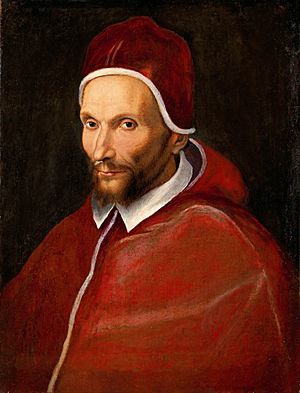Pope Urban VII facts for kids
Quick facts for kids Pope Urban VII |
|
|---|---|
| Bishop of Rome | |

|
|
| Church | Catholic Church |
| Papacy began | 15 September 1590 |
| Papacy ended | 27 September 1590 |
| Predecessor | Sixtus V |
| Successor | Gregory XIV |
| Orders | |
| Ordination | 30 March 1553 |
| Consecration | 4 April 1553 by Girolamo Verallo |
| Created Cardinal | 12 December 1583 |
| Personal details | |
| Birth name | Giovanni Battista Castagna |
| Born | 4 August 1521 Rome, Papal States |
| Died | 27 September 1590 (aged 69) Rome, Papal States |
| Previous post |
|
| Coat of arms | |
| Other Popes named Urban | |
Pope Urban VII, born Giovanni Battista Castagna, was the leader of the Catholic Church. He was also the ruler of the Papal States (a territory in Italy) from September 15 to September 27, 1590. His time as Pope lasted only thirteen days, making it the shortest papacy ever. During his short rule, he made a rule against smoking inside churches.
Contents
Early Life and Education
Giovanni Battista Castagna was born in Rome in 1521. His family was noble, meaning they came from an important and respected background. His father was Cosimo Castagna from Genoa, and his mother was Costanza Ricci Giacobazzi from Rome.
Giovanni studied at different universities across Italy. He earned a special degree in both civil law (laws for citizens) and canon law (church laws) from the University of Bologna. After finishing his studies, he became an assistant to his uncle, Cardinal Girolamo Verallo. He traveled with his uncle to France.
Giovanni worked as a lawyer for the church. He joined the Roman Curia, which is like the Pope's administration, during the time of Pope Julius III.
Church Career
Giovanni Battista Castagna became the new Archbishop of Rossano on March 1, 1553. An archbishop is a high-ranking bishop who oversees a large area. He quickly received all the necessary church orders. He became a priest on March 30, 1553, in Rome. A month later, he was consecrated as a bishop at his uncle Cardinal Verallo's home.
He served as the Governor of Fano from 1555 to 1559. Then, he was the Governor of Perugia and Umbria from 1559 to 1560. During the rule of Pope Pius IV, he helped solve a long-standing border problem between two towns, Terni and Spoleto.
Castagna also took part in the Council of Trent from 1562 to 1563. This was an important meeting of church leaders. He led several groups during the council. He was appointed as the Apostolic Nuncio to Spain in 1565 and stayed there until 1572. An Apostolic Nuncio is like an ambassador for the Pope. He later resigned from his role as archbishop.
He also served as the Governor of Bologna from 1576 to 1577. Among other jobs, he was the Pope's ambassador to Venice from 1573 to 1577. He also served as the Pope's representative to Flanders and Cologne from 1578 to 1580.
Pope Gregory XIII made him a cardinal on December 12, 1583. A cardinal is a senior church official, usually a bishop, who advises the Pope and can vote for a new Pope. He was given the title of Cardinal-Priest of San Marcello.
Papacy
Becoming Pope
After Pope Sixtus V died, a special meeting called a conclave was held to choose the next Pope. During this meeting, cardinals vote for a new leader.
One important person in the election was Ferdinando I de' Medici. He was a powerful figure who wanted to reduce Spain's influence in Italy. He convinced another cardinal, Alessandro Peretti di Montalto, to support a different candidate. This helped bring together the votes of younger cardinals.
Giovanni Battista Castagna was known as a wise diplomat. He was chosen as Pope on September 15, 1590. He chose the name "Urban VII" for his papacy.
Key Actions as Pope
Pope Urban VII's time as Pope was very short. However, he is famous for creating the world's first known public smoking ban. He said that anyone who used tobacco inside or near a church would be excommunicated. This meant they would be removed from the church community. This rule applied whether people were chewing tobacco, smoking it in a pipe, or sniffing it as powder.
Urban VII was also known for being very kind to the poor. He helped Roman bakers sell bread at a lower price than it cost to make. He also limited how much money people in his court could spend on fancy items. He supported public building projects across the Papal States. Pope Urban VII was strongly against nepotism. Nepotism is when someone in power gives jobs or favors to family members. He made sure this did not happen in the church administration.
Death
Pope Urban VII died in Rome on September 27, 1590. He passed away from malaria, a serious disease spread by mosquitoes. He had been Pope for only 13 days.
He was first buried in the Vatican. Later, on September 21, 1606, his remains were moved to the church of Santa Maria sopra Minerva.
Pope Urban VII left his money, which was worth about 30,000 scudi (an old Italian currency), to a charity. This charity, called the Archconfraternity of the Annunciation, used the money to provide dowries for poor young girls. A dowry was money or property given by a bride's family to her husband or his family upon marriage.
Images for kids
-
Reverse of 1590 coin in honor of Urban VII with menorah and the legend
SIC•LUCEAT•LUX•VESTRA
(Let your light so shine - Matt. 5:16)
See also
 In Spanish: Urbano VII para niños
In Spanish: Urbano VII para niños


